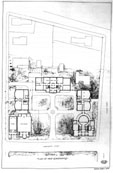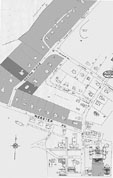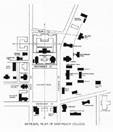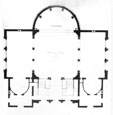|
I. The University Arrives
Epilogue

Fig. 74. Quadrangle Plan 182 Fredrick Chase, A History of Dartmouth College and the Town of Hanover to 1815 (Brattleboro: Vermont Printing Co., 1928), 575. 183 Leavens and Lord, 77. "To the Trustees of Dartmouth College." 
Fig. 75. Butterfield Museum 184 The Dartmouth 14 (27 January 1893): 123. 185 Tucker, My Generation, 309. The lone letter on this topic in The Dartmouth file in the Olmsted Papers is from Tucker to Charles Eliot, 19 June 1893, Olmsted Papers, Job # 1385, B9 Microfilm Reel 65, Manuscripts Division, Library of Congress. In the letter Tucker thanks Eliot for his work and mentions "the building in the park." 186 Tucker, My Generation, 309. 187 Trustees Records 5 (8 June, 1894): 113. 
Fig. 76. Quadrangle in 1895 Fig. 77. Quadrangle in 1901 Fig. 78. Quadrangle in 1910 188 "To the Trustees of Dartmouth College." 189 Levi P. Morton, Hanover merchant and later Vice-President under William Henry Harrison, bought the 1824 Rood House for the College in 1885 according to David Curtis, "Webster Hall at Dartmouth College," (term paper, U.N.H. Manchester, May 4, 1987), 1. 190 John King Lord, History of the Town of Hanover (Hanover: Dartmouth Press, 1928), 52; "To the Trustees of Dartmouth College." 191 "To the Trustees of Dartmouth College;" The Dartmouth 17 (12 June 1896): 529. The College later built Silsby Hall of 1927-8 on the site of the Kappa Kappa Kappa house and transferred this lot to that fraternity. 192 "To the Trustees of Dartmouth College." The College moved the house at 9 North Main Street for Baker Library ca. 1925. 193 Circular in President Tucker's papers, DP-9, file 4e, Special Collections, Dartmouth College Library, cited in Philip N. Cronenwett, "Notes from the Special Collections: The Transformation of Webster Hall," Dartmouth College Library Bulletin, n.s. 38, no. 2 (April 1998): 87. 194 The Dartmouth 16 (21 September 1894): opp. 1. 
Fig. 79. Perspective views of Quadrangle 195 New York Times (12 February 1895), 8. American Architect and Building News 49, no. 1024 (24 August 1895). 196 "To the Trustees of Dartmouth College." 197 Tucker, My Generation, 310. 
Fig. 80. Map of Webster Avenue and Occom Ridge, 1927 198 Tucker, My Generation, 310. 199 In 1896 Dwight & Chandler of Boston designed six houses on the north side of the new Webster Avenue, and fraternities bought the three remaining lots according to The Dartmouth 17 (12 June 1896): 529. Rich designed the Delta Kappa Epsilon house in 1896 according to the Rich [List of commissions] but the fraternity did not build it, selling the lot to Kappa Sigma, which built a house on it in 1915 according to Lord, History of the Town of Hanover, 68. The south side of the street was still part of Hiram Hitchcock's estate at this time and would only come to the College in 1912. The College built six houses along Occom Ridge to the designs of Louis H. Newton of Hartford, Vermont according to The Dartmouth 21 (9 March 1900): 345; Newton designed other buildings in town that appear in Frank J. Barrett, Jr., Hanover, New Hampshire, Images of America series (Dover, N.H.: Arcadia Publishing, 1997), 26, 48. Information on Olmsted & Olmsted's role comes from a letter from J.C. Olmsted to William Jewett Tucker, 28 December 1899, Olmsted Papers, Job # 1385, B9 Microfilm Reel 65, Manuscripts Division, Library of Congress; Olmsted's notes from a site visit and his proposal for a large horseshoe road around what is now Occom Pond are also in Job #1385. "To the Trustees of Dartmouth College." 
Fig. 81. Ridge House, now Delta Delta Delta 199 Architecture 18, no. 5 (15 November 1908), 177; The drafting style and naming inaccuracies indicate that Rich probably did not draw this plan, though it might have been based on a master plan of his. The fact that buildings like this would block the Butterfield Museum caused Rich to reject them according to a letter from Lewis Parkhurst to the Trustees, 1 June 1910, President Nichols's papers, file "Buildings (Administration Building)." 
Fig. 82. 1908 Master Plan 200 Passanti, 69; Trustees' Records 5 (8 June 1894): 112. 201 The Dartmouth 17 (20 September 1895): 7. 
Fig. 83. Court of Honor, World's Columbian Exposition (Gems of the World's Fair and Midway Plaisance, [unpaginated]). Fig. 84. Gibbs's buildings at Cambridge 202 Schuyler, "Architecture of American Colleges VI: Dartmouth, Williams and Amherst," 430, 434. 203 Roth, 122. 204 Passanti, 73. 
Fig. 85. Boston Public Library (Chamberlain). Fig. 86. Public Library, Newark, N.J. 205 Roth, 190. 
Fig. 87. Alumni Memorial Hall proposed west facade Fig. 88. Alumni Memorial Hall proposed second floor plan Fig. 89. Alumni Memorial Hall proposed south facade Fig. 90. Webster Hall Fig. 91. Gould Library, N.Y.U. (McKim, Mead and White, plate 76) Fig. 92. N.Y.U. site plan 206 The surviving sketches depict buildings that are larger than the 1895 Alumni Memorial Hall and would therefore seem to postdate it, since they do not have to accommodate the recitation hall that the College had dropped. The sketches also lack the connecting colonnades. The "Front" scheme also shows a "Memorial Hall" inscription above the pediment, showing that it probably predates 1900-1. 207 [Charles Alonzo Rich], "Two Sides," undated sketch on yellow trace, file "Alumni Memorial Hall," Special Collections, Dartmouth College Library; [Charles Alonzo Rich], "Front," undated sketch on yellow trace, file "Alumni Memorial Hall," Special Collections, Dartmouth College Library. 
Fig. 93. Alumni Memorial Hall proposed south facade Fig. 94. Alumni Memorial Hall proposed west facade 208 [Charles Alonzo Rich], "Section," undated sketch on yellow trace, file "Alumni Memorial Hall," Special Collections, Dartmouth College Library. 
Fig. 95. Alumni Memorial Hall proposed section 209 The Dartmouth 21 (26 January 1900): 245 describes the building only as an "academic hall with offices of administration." 210 Rich records the first of his two Webster Hall commissions in 1901 Rich [List of commissions]. Rich states that the design still had a dome at this time in a letter from Charles Alonzo Rich to William Jewett Tucker, 15 January 1908, President Tucker's papers, file 47a. Aegis 1903 (1902); in the same volume appears a small cut that a commercial engraver of fraternity insignia created. The depiction of the building simplifies the facade until it is nearly flat, with the stair domes appearing as lines in low relief. 
Fig. 96. Webster Hall proposed south facade in Aegis 1903 211 The Dartmouth 17 (20 September 1895): 6. 212 Parts of Tucker's 1907 dedication speech, in which he says that the foundation was finished in 1901, appear in The Dartmouth 28 (29 March 1907): 394. 213 Charles Alonzo Rich to William Jewett Tucker, 15 January 1908, President Tucker's papers, file 47a. Rich writes that a foundation was laid to this 1903 design that year. 214 Leavens and Lord, 199. Webster would also hold Commencements beginning in 1908, which the College Church had done since 1796. 215 William Jewett Tucker to Charles Alonzo Rich, 18 January 1908, President Tucker's Papers, file 47a. 216 Charles Alonzo Rich to William Jewett Tucker, 15 January 1908, President Tucker's papers, file 47a. Rich in his [List of commissions] notes the second of two College commissions for Webster Hall in 1906. 217 The Dartmouth 28 (29 March 1907): 394. 218 The Dartmouth 29 (22 October 1907): 75; Charles Alonzo Rich to Edgar Hayes Hunter, 1 July 1908, President Tucker's papers, file 47a; William H. Mosman of Chicopee, Massachusetts sculpted the doors on Rich's suggestion. 
Fig. 97. Webster Hall Fig. 98. Webster Hall second floor plan 219 Designs seem to have called for the buff brick at least through 1901 as noted in The Dartmouth 23 (20 September 1901): 3. 220 Paul Venable Turner, Campus: An American Planning Tradition (New York: Architectural History Foundation, 1990): 118. 221 Watercolor in file "Memorial Hall Richards and Park," Iconography 814 , Special Collections, Dartmouth College Library; Lord, History of Dartmouth College 1815-1901, 346. The College demolished the gymnasium for the Hopkins Center ca. 1952. 222 The Dartmouth 29 (22 October 1907): 75. 223 The Dartmouth 11 (2 March 1890): 323. 224 The Dartmouth 29 (22 October 1907): 76. 
Fig. 99. Webster Hall interior 225 Charles Alonzo Rich to William Jewett Tucker, 5 February 1909, President Tucker's papers, file 47a. 226 Ibid., 77. 227 Roth, 190. 228 The Dartmouth 20 (23 September 1898): 2. The College moved the building in 1920 and again in 1972 to make way for the Fairchild Center. Trustees' Records (1 October 1910): 59, photocopy in file "Hanover houses/historic houses," Special Collections, Dartmouth College Library. The College moved the house, usually known as the Choate House, in 1927 for Baker Library and again ca. 1966 for Kiewit. 229 Roth, 181; 209. 230 Veysey, 264. 231 Leavens and Lord, 55. 232 Parker, Thomas & Rice, "New College Hall for Dartmouth College," plans and perspective view, 12 January 1916, file "General," Iconography 456, Special Collections, Dartmouth College Library; [Report on Storehouse], April 1913, Dartmouth College Trustees, Committee on Business Administration, DA 502, Dartmouth College Library, Special Collections. The College first consulted LG&Co. on the Storehouse in 1912. The large engineering and mill-building firm had built the Athenaeum Press of Ginn & Co. in Cambridge of 1895 under the supervision of Dartmouth Trustee and avid builder Lewis Parkhurst. (Interestingly, Rich worked on the 1912 Boston headquarters of Ginn & Co.) 233 Committee on Buildings and Improvements Records 1 (18 March 1911): 19, Dartmouth College Trustees, Committee on Business Administration, Dartmouth College Library, Special Collections; Charles Alonzo Rich to Ernest Fox Nichols, 28 June 1911, President Nichols's papers, file 16a; Charles Alonzo Rich to Ernest Fox Nichols, 19 February 1914, President Nichols's Papers, file "Rich, Charles A." Rich wrote Hopkins in 1917 and 1919 according to letters from Ernest Martin Hopkins to Charles Alonzo Rich, 21 June 1917, President Hopkins's papers, file "Dart Coll Library," Special Collections, Dartmouth College Library, and Ernest Martin Hopkins to Charles Alonzo Rich, 24 February 1919, President Hopkins's papers, file "M-Z." 234 Isaac Blair & Co. Building Movers and Contractors to Charles Alonzo Rich, 25 July 1911, Presidents Nichols's papers, file 16a; John Russell Pope's 1922 plan shows the Museum moved back to make way for the library that he too proposed should stand at the axes of the Green and the Hitchcock Estate; the College built Tuck Mall on the estate after acquiring it in 1912. 235 Charles Alonzo Rich, "The Architect,"The Dartmouth16 (June 14, 1895): 319-21. 
Fig. 100. Butterfield Museum demolition 236 The Dartmouth 29 (22 October 1907): 75-6. 237 Charles Alonzo Rich to William Jewett Tucker, 6 July 1909, President Tucker's papers, file 47a. 238 Charles Alonzo Rich to Mr. and Mrs. Tucker, 24 December 1909. President Tucker's papers, file 47a. Rich retired in 1933 to a home he designed in Charlottesville, Virginia where he died in 1943. 
Fig. 101. Aerial view of campus, 1919.
|











